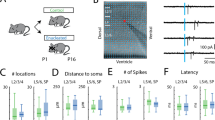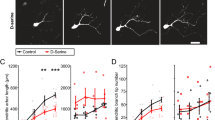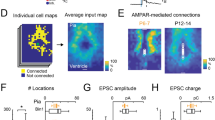Abstract
AFFERENT activity has an important role in the formation of connections in the developing mammalian visual system1,2. But the extent to which the activity of target neurons shapes patterns of afferent termination and synaptic contact is not known. In the ferret's visual pathway, retinal ganglion cell axons from each eye segregate early in development into eye-specific laminae in the lateral geniculate nucleus (LGN)3. The dorsal laminae (termed laminae A and Al) then segregate further into inner and outer sublaminae that retain input from on-centre and off-centre retinal axons, respectively4,5. Thus, individual retinogeniculate axons form terminal arbors within laminae A and Al that are restricted to one inner or outer sublamina6. We report here that blockade of N-methyl-D-aspartate (NMDA) receptors on LGN cells with specific antagonists during the period of sublamina formation prevents retinal afferents from segregating into 'On' and 'Off sublaminae. Retinogeniculate axons have arbors that are not restricted appropriately, or are restricted in size but inappropri-ately positioned within the eye-specific laminae. NMDA receptor antagonists may specifically disrupt a mechanism by which LGN neurons detect correlated afferent and target activity7, and have been shown to reduce retinogeniculate transmission more generally8–10, causing LGN cells to have markedly reduced levels of activity. These results therefore indicate that the activity of postsynaptic cells can significantly influence the patterning of inputs and the structure of presynaptic afferents during development.
This is a preview of subscription content, access via your institution
Access options
Subscribe to this journal
Receive 51 print issues and online access
$199.00 per year
only $3.90 per issue
Buy this article
- Purchase on Springer Link
- Instant access to full article PDF
Prices may be subject to local taxes which are calculated during checkout
Similar content being viewed by others
References
Movshon, J. A. & Van Sluyters, R. C. A. Rev. Psychol. 32, 477–522 (1981).
Sherman, S. M. & Spear, P. D. Physiol. Rev. 62, 740–855 (1982).
Linden, D. C. Guillery, R. W. & Cucchiaro, J. J. comp. Neurol. 203, 189–211 (1981).
Stryker, M. P. & Zahs, K. R. J. Neurosci. 3, 1943–1951 (1983).
Hahm, J. & Sur, M. Neurosci. Abstr 14, 460 (1988).
Roe, A. W., Garraghty, P. E. & Sur, M. J. comp. Neurol. 288, 208–242 (1989).
Constantine-Paton, M., Cline, H. T. & Debski, E. A. Rev. Neurosci. 13, 129–134 (1990).
Sillito, A. M., Murphy, P. C., Salt, T. E. & Moody, C. I. J. Neurophysiol. 63, 347–355 (1990).
Heggelund, P. & Hartveit, E. J. Neurophysiol. 63, 1347–1360 (1990).
Kwon, Y. H., Esguerra, M. & Sur, M. J. Neurophysiol. (in the press).
Cline, H. T., Debski, E. & Constantine-Paton, M. Proc. natn. Acad. Sci. U.S.A. 84, 4342–4345 (1987).
Cline, H. T. & Constantine-Paton, M. Neuron 3, 413–426 (1989).
Cline, H. T. & Constantine-Paton, M. J. Neurosci. 10, 1197–1216 (1990).
Scherer, W. J. & Udin, S. B. J. Neurosci. 9: 3837–3843 (1989).
Bear, M. F., Kleinschmidt, A., Gu, Q. & Singer, W. J. Neurosci. 10, 909–925 (1990).
Reiter, H. O. & Stryker, M. P. Proc. natn. Acad. Sci. U.S.A. 85, 3623–3627 (1988).
Miller, K. D., Chapman, B. & Stryker, M. P. Proc. natn. Acad. Sci. U.S.A. 86, 5183–5187 (1989).
Fox, K., Sato, H. & Daw, N. J. Neurosci. 9, 2443–2454 (1989).
Langdon, R. B. & Sur, M. J. Neurophysiol. 64, 1484–1501 (1990).
Shatz, C. J. & Stryker, M. P. Science 242, 87–89 (1988).
Sretavan, D. W., Shatz, C. J. & Stryker, M. P. Nature 336, 468–471 (1988).
Esguerra, M. & Sur, M. Neurosci. Abstr. 16, 159 (1990).
Esguerra, M., Kwon, Y. H. & Sur, M. Neurosci. Abstr. 15, 175 (1989).
Zahs, K. R. & Stryker, M. P. J. comp. Neurol. 241, 210 (1985).
Author information
Authors and Affiliations
Rights and permissions
About this article
Cite this article
Hahm, JO., Langdon, R. & Sur, M. Disruption of retinogeniculate afferent segregation by antagonists to NMDA receptors. Nature 351, 568–570 (1991). https://doi.org/10.1038/351568a0
Received:
Accepted:
Issue Date:
DOI: https://doi.org/10.1038/351568a0
This article is cited by
-
Juvenile depletion of microglia reduces orientation but not high spatial frequency selectivity in mouse V1
Scientific Reports (2022)
-
Chemical Neurotransmission from Retinal Ganglion Cells to Superior Colliculus Neurons under Conditions of Long-Lasting Neighboring Co-Culturing
Neurophysiology (2012)
-
Activity-dependent disruption of intersublaminar spaces and ABAKAN expression does not impact functional on and off organization in the ferret retinogeniculate system
Neural Development (2011)
-
Electrical activity and development of neural circuits
Nature Neuroscience (2001)
-
Visual input induces long-term potentiation of developing retinotectal synapses
Nature Neuroscience (2000)
Comments
By submitting a comment you agree to abide by our Terms and Community Guidelines. If you find something abusive or that does not comply with our terms or guidelines please flag it as inappropriate.



